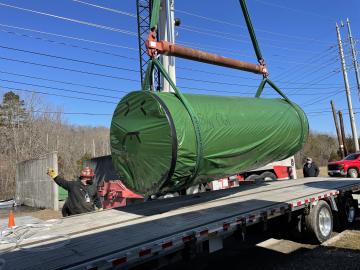Filter News
Area of Research
- (-) Neutron Science (16)
- (-) Supercomputing (21)
- Advanced Manufacturing (7)
- Biology and Environment (37)
- Building Technologies (1)
- Clean Energy (69)
- Computational Biology (1)
- Computational Engineering (2)
- Computer Science (4)
- Electricity and Smart Grid (1)
- Fusion and Fission (14)
- Fusion Energy (1)
- Isotopes (12)
- Materials (15)
- Materials for Computing (18)
- Mathematics (1)
- National Security (7)
- Nuclear Science and Technology (1)
- Quantum information Science (3)
- Sensors and Controls (1)
- Transportation Systems (1)
News Topics
- 3-D Printing/Advanced Manufacturing (2)
- Artificial Intelligence (3)
- Biology (2)
- Biomedical (2)
- Buildings (1)
- Chemical Sciences (1)
- Climate Change (3)
- Computer Science (16)
- Coronavirus (3)
- Cybersecurity (2)
- Energy Storage (2)
- Environment (6)
- Frontier (3)
- Fusion (1)
- High-Performance Computing (10)
- Machine Learning (1)
- Materials (3)
- Materials Science (6)
- Microscopy (2)
- Nanotechnology (2)
- National Security (1)
- Neutron Science (14)
- Physics (2)
- Quantum Computing (5)
- Quantum Science (4)
- Security (1)
- Space Exploration (1)
- Summit (5)
- Sustainable Energy (1)
- Transportation (2)
Media Contacts

The receipt of a nuclear fuel canister is boosting the research of an Oak Ridge National Laboratory team investigating methods to help the nation effectively dispose of nuclear waste for the long term.

ASM International recently elected three researchers from ORNL as 2021 fellows. Selected were Beth Armstrong and Govindarajan Muralidharan, both from ORNL’s Material Sciences and Technology Division, and Andrew Payzant from the Neutron Scattering Division.

Scientists at ORNL and the University of Tennessee, Knoxville, have found a way to simultaneously increase the strength and ductility of an alloy by introducing tiny precipitates into its matrix and tuning their size and spacing.

An ORNL-led team comprising researchers from multiple DOE national laboratories is using artificial intelligence and computational screening techniques – in combination with experimental validation – to identify and design five promising drug therapy approaches to target the SARS-CoV-2 virus.

RamSat’s mission is to take pictures of the forests around Gatlinburg, which were destroyed by wildfire in 2016. The mission is wholly designed and carried out by students, teachers and mentors, with support from numerous organizations, including Oak Ridge National Laboratory.

Researchers from NASA’s Jet Propulsion Laboratory and Oak Ridge National Laboratory successfully created amorphous ice, similar to ice in interstellar space and on icy worlds in our solar system. They documented that its disordered atomic behavior is unlike any ice on Earth.

The Department of Energy’s Office of Science has selected five Oak Ridge National Laboratory scientists for Early Career Research Program awards.

At the Department of Energy’s Oak Ridge National Laboratory, scientists use artificial intelligence, or AI, to accelerate the discovery and development of materials for energy and information technologies.

The Department of Energy’s Oak Ridge National Laboratory has licensed its award-winning artificial intelligence software system, the Multinode Evolutionary Neural Networks for Deep Learning, to General Motors for use in vehicle technology and design.

From Denmark to Japan, the UK, France, and Sweden, physicist Ken Andersen has worked at neutron sources around the world. With significant contributions to neutron scattering and the scientific community, he’s now serving in his most important role yet.




